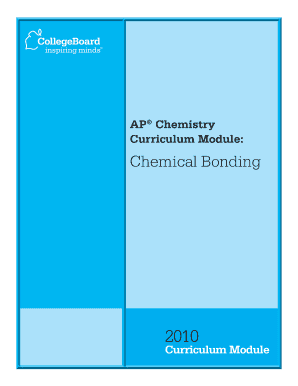Loading

Get Ap Chemistry Curriculum Module Chemical Bonding Form
How it works
-
Open form follow the instructions
-
Easily sign the form with your finger
-
Send filled & signed form or save
How to fill out the AP Chemistry Curriculum Module Chemical Bonding Form online
This guide provides a clear, step-by-step approach to filling out the AP Chemistry Curriculum Module Chemical Bonding Form online. By following these instructions, users can easily complete the form and ensure all necessary information is accurately provided.
Follow the steps to successfully fill out the form.
- Click the 'Get Form' button to download the form and open it in the online editor.
- Begin with the personal information section. Fill in your full name and contact details in the designated fields. Ensure that all information is accurate to avoid processing delays.
- Proceed to the educational background section. Indicate your current academic status, including any relevant courses or achievements related to chemistry.
- In the next section, express your interest in the AP Chemistry module. Provide a brief explanation of why you wish to study chemical bonding and how it relates to your academic goals.
- Review the confirmation section wherein you will affirm that the information provided is accurate. Be sure to read any additional notes or instructions provided within this area.
- Finally, once all sections are complete, save your progress. You can then choose to download, print, or share the form for submission.
Complete your AP Chemistry Curriculum Module Chemical Bonding Form online today to stay on track with your studies.
AP Chemistry delves deeper into concepts compared to regular chemistry classes. It emphasizes analytical thinking and problem-solving. If you're seeking thorough preparation, the AP Chemistry Curriculum Module Chemical Bonding Form offers extensive resources to help bridge any gaps in understanding between the two courses.
Industry-leading security and compliance
US Legal Forms protects your data by complying with industry-specific security standards.
-
In businnes since 199725+ years providing professional legal documents.
-
Accredited businessGuarantees that a business meets BBB accreditation standards in the US and Canada.
-
Secured by BraintreeValidated Level 1 PCI DSS compliant payment gateway that accepts most major credit and debit card brands from across the globe.


